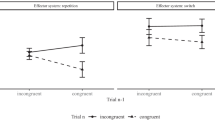Abstract
The validity conditions for univariate repeated measures designs are described. Attention is focused on the sphericity requirement. For av degree of freedom family of comparisons among the repeated measures, sphericity exists when all contrasts contained in thev dimensional space have equal variances. Under nonsphericity, upper and lower bounds on test size and power of a priori, repeated measures,F tests are derived. The effects of nonsphericity are illustrated by means of a set of charts. The charts reveal that small departures from sphericity (.97 ≤ ɛ<1.00) can seriously affect test size and power. It is recommended that separate rather than pooled error term procedures be routinely used to test a priori hypotheses.
Similar content being viewed by others
References
Boik, R. J. Interactions in the analysis of variance: A procedure for interpretation and a Monte Carlo comparison of univariate and multivariate methods for repeated measures designs (Doctoral dissertation, Baylor University, 1975).Dissertation Abstracts International, 1975,36, 2908B. (University Microfilms No. 75-27, 837).
Boik, R. J. Interactions, partial interactions, and interaction contrasts in the analysis of variance.Psychological Bulletin, 1979,86, 1084–1089.
Boik, R. J., & Kirk, R. E. A general method for partitioning sums of squares of treatments and interactions in the analysis of variance.Educational and Psychological Measurement, 1977,37, 1–9.
Box, G. E. P. Some theorems on quadratic forms in the study of analysis of variance problems, I. Effect of inequality of variances and correlation between errors in the two-way classification.Annals of Mathematical Statistics, 1954b,25, 484–498.
Bradu, D., & Gabriel, K. R. Simultaneous statistical inference on interactions in two way analysis of variance.Journal of the American Statistical Association, 1974,69, 428–436.
Cole, J. W., & Grizzle, J. E. Applications of multivariate analysis to repeated measurements experiments,Biometrics, 1966,22, 810–828.
Collier, R. O., Baker, F. B., Mandeville, G. K., and Hays, T. F. Estimates of test size for several procedures based on conventional variance ratios in the repeated measure design.Psychometrika, 1967,32, 339–353.
Danford, M. B., Hughes, H. M., & McNee, R. C. On the analysis of repeated-measurements experiments.Biometrics, 1960,16, 547–565.
Edgington, E. S. A new tabulation of statistical procedures used in APA journals.American Psychologist, 1974,29, 25–26.
Gabriel, K. R., Putter, J., & Wax, Y. Simultaneous confidence intervals for product-type interaction contrasts.Journal of the Royal Statistical Society, 1973,35, 234–244.
Geisser, S., & Greenhouse, S. W. An extension of Box's results on the use of theF distribution in multivariate analysis.Annals of Mathematical Statistics, 1958,29, 885–891.
Graybill, F. Variance heterogeneity in a randomized block design.Biometrics, 1954,10, 516–520.
Greenhouse, S. W., & Geisser, S. On methods in the analysis of profile data.Psychometrika, 1959,24, 95–112.
Hotelling, H. The generalization of “Students ratio.”Annals of Mathematical Statistics, 1931,2, 360–378.
Huynh, H. Some approximate tests for repeated measures designs.Psychometrika, 1978,43, 161–175.
Huynh, H., & Feldt, L. S. Conditions under which mean square ratios in repeated measurements designs have exactF distributions.Journal of the American Statistical Association, 1970,65, 1582–1589.
Huynh, H., & Feldt, L. S. Estimation of the Box correction for degrees of freedom from sample data in the randomized block and split-plot designs.Journal of Educational Statistics, 1976,1, 69–82.
Huynh, H., & Mandeville, G. K. Validity conditions in repeated measures designs.Psychological Bulletin, 1979,86, 964–973.
International Mathematical and Statistical Libraries, Edition 6. International Mathematical and Statistical Libraries, Inc., Houston, 1977.
Johnson, D. E. Some new multiple comparison procedures for the two-way AOV model with interaction.Biometrics, 1976,32, 929–934.
Keselman, H. J., Rogan, J. C., Mendoza, J. L., & Breen, L. J. Testing the validity conditions of repeated measuresF tests.Psychological Bulletin, 1980,87, 479–481.
Kirk, R. E.Experimental design: Procedures for the behavioral sciences. Belmont, California: Brooks/Cole, 1968.
Mauchley, J. W. Significance test for sphericity of a normaln-variate distribution.Annals of Mathematical Statistics, 1940,11, 204–209.
Maxwell, S. E. Pairwise multiple comparisons in repeated measures designs.Journal of Educational Statistics, 1980,5, 269–287.
Mendoza, J. L., Toothaker, L. E., & Crain, B. R. Necessary and sufficient conditions forF ratios in theL ×J ×K factorial design with two repeated factors.Journal of the American Statistical Association, 1976,71, 992–993.
Mendoza, J. L., Toothaker, L. E., & Nicewander, W. A. A Monte Carlo comparison of the univariate and multivariate methods for the groups by trials repeated measures design.Multivariate Behavioral Research, 1974,9, 165–177.
Mudholkar, G. S., & Subbaiah, P. Unequal precision multiple comparisons for randomized block design under nonstandard conditions.Journal of the American Statistical Association, 1976,71, 429–434.
Ramsey, P. H. Exact Type I error rates for robustness of Student'st test with unequal variances.Journal of Educational Statistics, 1980,5, 337–349.
Rogan, J. C., Keselman, H. J., & Mendoza, J. L. Analysis of repeated measurements.British Journal of Mathematical and Statistical Psychology, 1979,32, 269–286.
Rouanet, H., & Lepine, D. Comparison between treatments in a repeated measures design: ANOVA and multivariate methods.The British Journal of Mathematical and Statistical Psychology, 1970,23, 147–163.
Roy, S. N. On a heuristic method of test construction and its use in multivariate analysis.Annals of Mathematical Statistics, 1953,24, 220–238.
Scheffé, H. A “mixed model” for the analysis of variance.Annals of Mathematical Statistics, 1956,27, 23–26.
Stoloff, P. H. Correcting for heterogeneity of covariance for repeated measures designs of the analysis of variance.Educational and Psychological Measurement, 1970,30, 909–924.
Tiku, M. L. Laguerre series forms of non-centralx 2 andF distributions.Biometrika, 1965,52, 415–427.
Wilks, S. S. Certain generalizations in the analysis of variance.Biometrika, 1932,24, 471–494.
Wilson, K. The sampling distributions of conventional, conservative and correctedF-ratios in repeated measurements designs with heterogeneity of covariance.Journal of Statistical Computation and Simulation, 1975,3, 201–215.
Winer, B. J.Statistical Principles in experimental design (2nd Ed.). New York: McGraw Hill, 1971.
Author information
Authors and Affiliations
Additional information
Appreciation is extended to Milton Parnes for his insightful assistance.
Rights and permissions
About this article
Cite this article
Boik, R.J. A priori tests in repeated measures designs: Effects of nonsphericity. Psychometrika 46, 241–255 (1981). https://doi.org/10.1007/BF02293733
Received:
Revised:
Issue Date:
DOI: https://doi.org/10.1007/BF02293733




